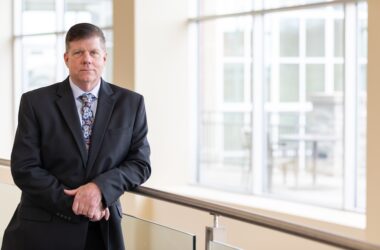LEWISBURG, W.Va. – Michelle Endicott, D.O., of the West Virginia School of Osteopathic Medicine’s (WVSOM) Class of 2001, has bad news and good news for aspiring dermatologists.
The native of Point Pleasant, W.Va., who in 2005 founded a successful practice called South Charleston Dermatology, said the competitive nature of residency programs in the specialty means there are far more medical students interested in the profession than opportunities to enter it.
“It’s not going to be popular to say this, but to get into a dermatology residency, you have to be at the top of your class. You have to do really well on your board exams, and these days you have to do research and present dermatology cases,” Endicott said. “Somebody who’s in the middle of their class might make a great dermatologist, but it’s probably going to be difficult for them. It’s unfair, but there just aren’t enough residencies.”
But for those who do enter the specialty focusing on the body’s largest organ, the rewards are plentiful.
“I love that I get to see all age groups. I might see a newborn in one room and a 92-year-old in the next room. That’s great, because it keeps you from getting bored. And even though I’m a specialist, I’m in the trenches along with our primary care doctors serving the people of West Virginia. Throughout the week, I’ll get texts from physicians asking, ‘Will you look at this rash?’ or ‘I’ve got this melanoma. Can you work it in?’ Also, the lifestyle is good: You can work Monday through Friday, and you can have holidays off,” she said.
As a child suffering from psoriasis and psoriatic arthritis, Endicott became interested in the profession after seeing a dermatologist from a young age. She attended college at Alderson Broaddus University in Philippi, W.Va., with the goal of becoming a physician assistant, but transferred to West Virginia University after deciding to pursue medical school. After three years as a biology major at WVU, Endicott applied to WVSOM and was accepted — placing her among the small number of students attending the medical school without an undergraduate degree.
“Having a mentor changes everything, and mine was Daniel Trent, D.O., a WVSOM graduate from Point Pleasant. I spent spring break shadowing him, and he told me I could enter medical school after 90 hours of undergrad work. He said, ‘Just apply.’ I did, and I got in,” she said.
After graduating as one of the top five students in WVSOM’s Class of 2001, Endicott completed an osteopathic rotating internship at Charleston Area Medical Center and a dermatology residency at Ohio’s Case Western Reserve University.
Her residency path represents one of three options available to dermatologists. Endicott explained that the specialty requires four years of residency work. In the first year, residents study internal medicine, surgery or complete a rotating internship. For the remaining three years, the focus is purely dermatology.
In 2005, she established her private practice, South Charleston Dermatology. While some members of the profession concentrate on cosmetic work, Endicott primarily provides care for medical conditions.
“About 99 percent of my practice is medical, because that is the need here,” she said. “We see a lot of skin cancer, because West Virginia has a lot of people who work outside. The state also has a lot of people who smoke, and it has coal miners who have soot sitting on their skin all day. All those environmental exposures put West Virginians at higher risk.”
Dermatology changes rapidly, requiring specialists to keep up with advances in pharmacological treatments. Endicott said that in the approximately two decades she has worked in the specialty, she’s seen dramatic improvements in treatments for conditions that previously were debilitating or fatal.
“We now have medications that can make real differences in people’s lives. We can take someone with psoriasis and allow them to only have to think about their disease, say, once a month when they take their medication. We can dramatically improve a patient’s eczema. And people are living much longer with melanoma. It used to be a death sentence, but today even metastatic melanoma is being treated with immunotherapy, drastically changing the patient’s prognosis,” she said.
Additionally, she said, dermatologists must stay up to date on medical fields outside their specialty.
“Psoriasis often has comorbidities of high blood pressure, hyperlipidemia and diabetes, so we check patients for those all the time,” she said. “We also see a lot of drug rashes, so we have to know the side effects of, say, the new diabetes medications and how they might impact our patients.”
Endicott has been voted a “Best in the Valley” physician three of the past four years by readers of the Charleston Gazette-Mail. In 2020, she sold South Charleston Dermatology to DOCS (Dermatologists of Central States), a Cincinnati, Ohio-based company that operates practices in West Virginia, Ohio, Illinois, Indiana, Michigan, North Carolina and Pennsylvania. In addition to providing dermatology services through DOCS, Endicott serves as a preceptor for medical students. She said she enjoys working with students on elective dermatology rotations — even the ones who have misconceptions about what her profession entails.
“Sometimes when people rotate here, they don’t realize how much medicine we do. They think we tell people what kind of makeup to use, and we don’t actually do that,” she said. “But I can honestly say that my students always teach me something. I’ve never had a bad student from WVSOM.”
WVSOM is a national leader in educating osteopathic physicians for primary care medicine in rural areas. Visit WVSOM online at www.wvsom.edu.



